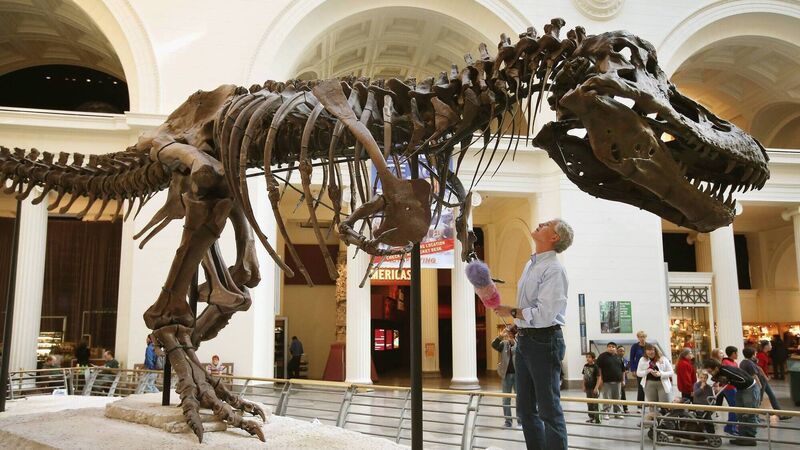Tyrannosaurus Rex may have been three species, scientists say

Geologist Bill Simpson cleans Sue, a 67-million-year-old Tyrannosaurus Rex on display at the Field Museum in Chicago. The species may have been one of a few tyrannosaurus species that evolved over their million-or-so years on Earth. Photo: Scott Olson/Getty Images
With its immense size, dagger-like teeth and sharp claws, Tyrannosaurus Rex was a fearsome predator that once terrorised North America. Now researchers studying its fossils have suggested the beast may not have been the only tyrannosaurus species.
Experts studying remains thought to belong to T-Rex have suggested their variation shows evidence of not one species but three.
The lead author of the research, Gregory Paul, who was a dinosaur specialist on the film Jurassic Park, said the findings had multiple implications, noting that previously experts had studied the growth of the T-Rex using remains from different rock layers.
“That may not be a good idea to do because you may be [looking at] different species,” he said.
The team say it is to be expected that more than one tyrannosaurus species evolved over their million-or-so years on Earth, as has been found for other dinosaurs who lived at the same time, such as triceratops.
Writing in the journal Evolutionary Biology, Paul and colleagues report how previous work has revealed that fossilised bones designated as being from T-Rex vary in terms of their stout build or “robustness”, and different specimens had one or two pairs of lower incisor-like teeth.
Paul and colleagues studied a total of 37 specimens attributed to T-Rex, in particular looking at the length and circumference of the thigh bones, available for about two-thirds of the specimens, to assess their robustness.
The team say their findings suggest differences in the robustness of the thigh bones are unlikely to be down to individual variation.
“We found that the robustness in the sample we have of tyrannosaurus, the variation of the femur is greater than all other tyrannosaurids combined over 10 million years of evolution,” said Paul. “You can’t just not pay attention to that.”
The team say the variation does not appear to be linked to the overall size of the specimen or how mature the animal was when it died, while other factors – such as the uneven ratio of more robust bones to those that were more slender, or “gracile” – suggests such variation is unlikely to be linked to the sex of the beasts.
What’s more, fossils with more gracile bones were only found in higher layers of sediment, and these and more robust specimens found alongside them tended to have only one incisor-like tooth in the lower jaw, in contrast to the robust specimens in lower layers.
While the team say they cannot rule out other explanations for the findings, they propose that specimens found in lower layers are probably from one species they have called Tyrannosaurus imperator or tyrant lizard emperor; the later, stocky-boned specimens are from Tyrannosaurus Rex; and the slender-boned specimens are from a third species the team have called Tyrannosaurus regina, or tyrant lizard queen.
Professor Steve Brusatte, a palaeontologist at the University of Edinburgh who was not involved in the work, said he was not convinced.
“I understand the temptation to divide T-Rex into different species because there is some variation in the fossil bones that we have. But ultimately, to me, this variation is very minor and not indicative of meaningful biological separation of distinct species that can be defined based on clear, explicit, consistent differences,” he said.









